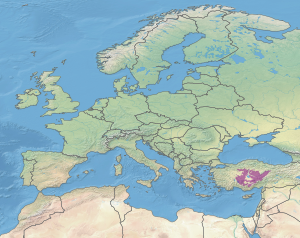Central Anatolian deciduous forests
The Central Anatolian deciduous forests, also known as the Central Anatolian woodlands and steppe, is a Palearctic ecoregion of the Temperate broadleaf and mixed forest biome. It is located in Central Anatolia, Asian Turkey.
| Central Anatolian deciduous forests | |
|---|---|
 location map of the Central Anatolian deciduous forests | |
| Ecology | |
| Realm | Palearctic |
| Biome | temperate broadleaf and mixed forests |
| Borders | |
| Geography | |
| Area | 101,493 km2 (39,187 sq mi) |
| Countries | Turkey |
| Conservation | |
| Conservation status | Vulnerable |
| Protected | 382 km² (>1%)[1] |
Geography
The ecoregion occupies the plateau of Central Anatolia. Belts of forested mountains surround the ecoregion, with the Mediterranean-climate Anatolian conifer and deciduous mixed forests and Southern Anatolian montane conifer and deciduous forests ecoregions in western and southern mountains, and the more temperate-climate Northern Anatolian conifer and deciduous forests in the ranges to the north. The eastern edge of the ecoregion approximates the Anatolian diagonal, a biogeographic boundary which separates central from eastern Anatolia. The Eastern Anatolian deciduous forests ecoregion lies generally east of the diagonal.
The driest portions of the plateau, including the area around Lake Tuz, are part of the distinct Central Anatolian steppe ecoregion.
The northern part of the ecoregion is drained by the Sakarya and Kızılırmak rivers. The southern portion occupies several closed lake basins, including Lake Tuz.
Ankara, Turkey's capital, lies in the northern portion of the ecoregion. Other cities in the ecoregion are Konya, Kayseri, Karaman, and Sivas.
Climate
The climate of the ecoregion is continental, with hot summers and cold winters. Rainfall ranges annual rainfall ranges from 400 to 600 mm.[2]
Flora
The characteristic vegetation of the ecoregion is dry deciduous forest interspersed with areas of shrub steppe. Human activity has transformed most of the region into anthropogenic steppe or open woodland.[3] The forests which once covered 50 to 55% of the region now cover less than 10%.[4] Oaks, including Quercus pubescens and Quercus infectoria, are the predominant trees. At higher elevations, Q. pubescens is joined by Pinus nigra, Juniperus oxycedrus, and Juniperus excelsa. The steppe plants include herbs, grasses, and low shrubs, with species of Artemisia, Bromus, Achillea, Trifolium, and Astragalus prominent.[2]
Trees are absent from areas with less than 400 mm of annual rainfall. These areas constitute the 'true steppe' of the Central Anatolian steppe ecoregion.[2]
Protected areas
Protected areas include Bozdağ National Park and Sultan Sazlığı National Park.
External links
- "Central Anatolian deciduous forests". Terrestrial Ecoregions. World Wildlife Fund.
References
- Dinerstein, Eric; Olson, David; et al. (June 2017). "An Ecoregion-Based Approach to Protecting Half the Terrestrial Realm". BioScience. 67 (6): 534–545. doi:10.1093/biosci/bix014.CS1 maint: date and year (link) Supplemental material 2 table S1b.
- Kapur, Selim, Erhan Akça, and Hikmet Günal (2017). The Soils of Turkey. Springer, Sep 30, 2017
- "Central Anatolian steppe". Terrestrial Ecoregions. World Wildlife Fund.
- Atalay, Ibrahim (1986). "Vegetation formations of Turkey". Travaux de l'Institut de Géographie de Reims, Année 1986 65-66. pp. 17-30.